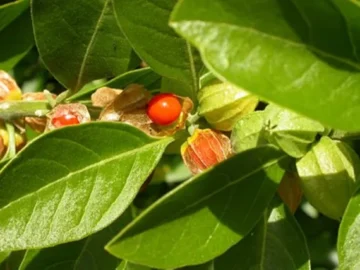Benefits of Seed Cycling for PMS Symptoms
Seed cycling for PMS symptoms is an approach worth considering for those who struggle with hormone imbalances. Women’s hormones are part of a complex system that needs to be delicately balanced. Several factors influence these hormones, including diet, exercise, sleep, stress levels, and environmental toxins. As a result, any of these factors can disturb your delicate hormone balance. A slight hormone imbalance can become the underlying issue for several health concerns, including pre-menstrual syndrome (PMS), periods, acne, PCOS, thyroid disorders, infertility, and chronic fatigue.
The practice of seed cycling is an all-natural and harmless method of supporting hormone balance that can be easily incorporated into your diet. It is important to note that seed cycling alone will not be the cure-all for PMS symptoms, but numerous research studies have shown that when used consistently (along with other healthy hormone-balancing practices), it can have a significant impact. Let’s discuss seed cycling – what it is, how it works, and how to incorporate it into your daily life.
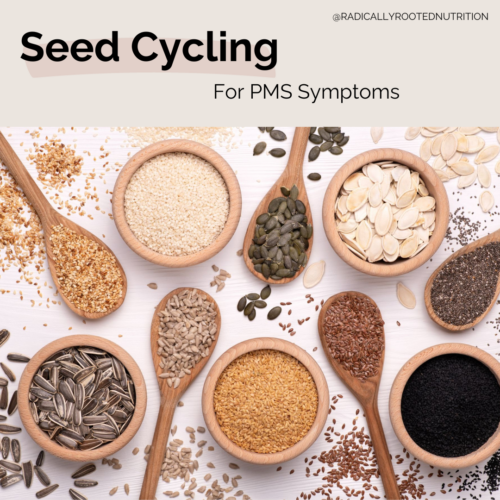
Seed Cycling: what is it?
Seed cycling has become a popular dietary trend recently, for a good reason. Used properly, seed cycling can be a great way to not only get in some really important nutrients but to help support a healthy hormone balance naturally. Seed cycling involves eating 4 types of seeds at different times of the month to balance hormones associated with your menstrual cycle. The rotation of various seeds during the follicular and luteal phases promotes a healthy balance of estrogen and progesterone levels, which plays a crucial role in menstrual cycles and fertility.
To understand seed cycling, it is important to understand the phases of your menstrual cycle.
- The first phase is called the follicular phase. It begins on the first day of menstruation and continues until ovulation occurs. (lasts ~6-14 days). During this phase, estrogen rises while progesterone stays low.
- The second phase is called the luteal phase. It begins after ovulation (~day 14) and ends just before menstrual bleeding. The luteal phase length may vary but it typically lasts around 14 days. During this phase, progesterone levels start to rise and estrogen levels will slowly decline. If pregnancy doesn’t take place, progesterone levels fall, which causes the lining of the uterus to shed and the cycle starts again.
Estrogen’s role is basically to help grow, thicken and mature the uterine lining (which is then shed during menstruation) as well as to assist with the maturation of the egg before conception.
Progesterone is known as our ‘relaxing hormone’, progesterone maintains the endometrial lining to assist a fertilized egg from implanting in the uterus.
An imbalance between estrogen and progesterone can contribute to PMS symptoms, menstrual cramps, acne, short luteal phases, anovulation, irregular cycles, and amenorrhea.
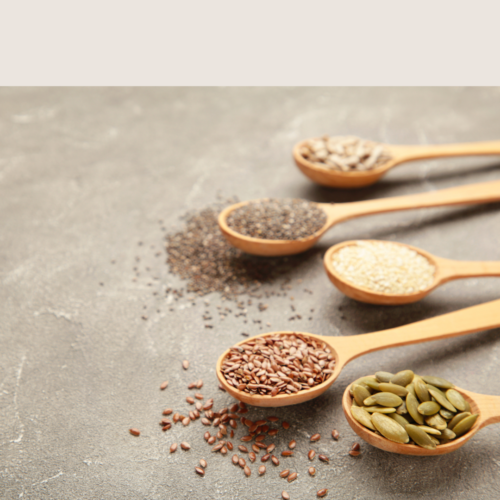
The Seed Cycling Process
The process of seed cycling is quite simple. During the follicular phase of the menstrual cycle, 1-2 tablespoons of pumpkin and flax seeds are incorporated daily into the diet. After ovulation, you will switch over to sunflower and sesame seeds during this luteal phase. Let’s take a look at the process outlined below…
Phase 1 – Follicular phase- menstruation until ovulation (days 1-14 of your cycle)
- Eat 1 tablespoon of freshly ground flax seeds per day, and
- Eat 1 tablespoon of freshly ground pumpkin seeds per day
The fiber and lignans found in pumpkin seeds and flax seeds play an important role in estrogen metabolism and prevent estrogen dominance by supporting healthy estrogen levels in the body. It has been shown that flax seeds can lengthen the luteal phase, improve ovulation, and reduce PMS symptoms such as breast pain and cramps. The omega-3 essential fatty acids in flax seeds and pumpkin seeds have anti-inflammatory properties that can reduce inflammation in the body, thereby reducing the symptoms of PMS. Omega-3 promotes blood flow to the uterus, increases progesterone secretion, and helps maintain cell membranes. They are also rich in nutrients like zinc and selenium which are vital to help produce healthy hormones. The zinc content in pumpkin seeds supports progesterone production by helping the pituitary gland regulate the production of follicle-stimulating hormone (FSH) during the follicular phase. Previous studies have shown that including flaxseeds in the diet can decrease androgen levels in women with PCOS, which can cause excess hair growth and acne, plus improve the cyclical breast tenderness that affects many women before their period.
Phase 2 – Luteal phase- ovulation until menstruation (days 15 to 28-35 of your cycle)
- Eat 1 tablespoon of freshly ground sesame seeds per day, and
- Eat 1 tablespoon of freshly ground sunflower seeds per day
Sesame seeds and sunflower seeds help boost progesterone production. Like flaxseeds, sunflower seeds and sesame seeds contain lignans and essential fatty acids like omega-6 that help to block excess estrogen and support a healthy hormone balance. Like pumpkin seeds, sesame seeds are a rich source of zinc. As noted, zinc assists with FSH production in the follicular phase which transforms the follicle into the corpus luteum. The corpus luteum is responsible for producing progesterone which stimulates the uterus to thicken in preparation for potential implantation. Research shows that menopausal women can benefit from consuming sesame seeds, which have been proven to enhance blood lipids, sex hormones, and antioxidants. Sunflower seeds are high in vitamin E and selenium. Vitamin E can improve corpus luteum blood flow which is critical for the luteal phase. Vitamin E has also been linked to reducing PMS symptoms. Selenium promotes the secretion of luteinizing hormone (LH) from the pituitary gland which is essential for ovulation and the production of progesterone.
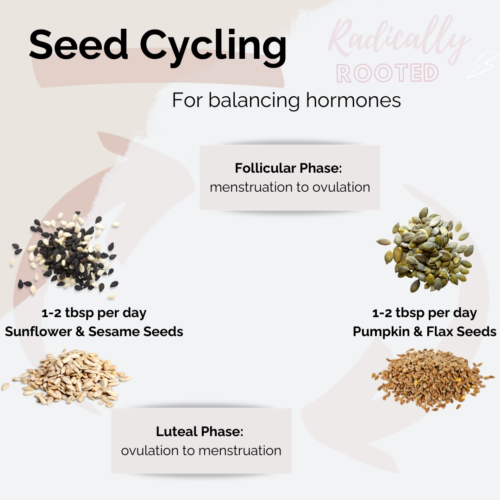
You might be thinking, well what if I don’t get a period?
This is the case for many women. This may sound odd but for those women who may have irregular periods, no periods at all (amenorrhea) or who are postpartum or postmenopausal, seed cycling is best timed with the moon cycle. Yes, the moon cycle. In this case, you would start phase one on the first day of the new moon by ingesting a combination of flax seeds and pumpkin seeds. After about 14 days, upon the arrival of the full moon, you will proceed to phase two by consuming sunflower and sesame seeds. It is important to keep track of your phases along with the moon phases to make sure that you are on the correct track.
How to incorporate seed cycling into your daily routine
It’s important to track the length of your menstrual cycle and pinpoint the start of the follicular and luteal phases.
It is recommended to incorporate 1-2 tablespoons of each specified seed type into your daily diet for optimal results.
It is best to purchase fresh, whole seeds and grind them before consuming them (you can use a blender, coffee bean grinder or spice grinder). It is not recommended to use pre-ground seeds since they are prone to oxidation, which can cause them to go rancid and lose therapeutic benefits. It is recommended to grind the seeds (specifically flax seeds) in order to extract more nutrients from them as whole seeds don’t break down completely in the gut.
You can add your seeds to basically anything. Some ideas are adding them to smoothies, sprinkling them on top of yogurt, toast, salads and soups, adding them to homemade granola or baking them into muffins. Prepare a 2-3 day batch in advance and store them in an airtight container in the fridge to prevent oxidation.
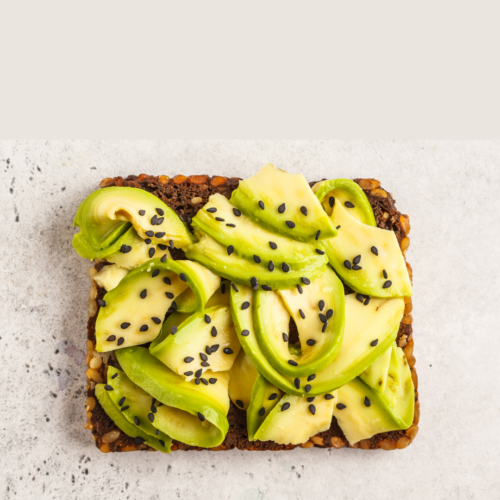

How long does it take to see results from seed cycling?
Seed cycling takes time to work with your body. It can take at least three months of daily use to start noticing the benefits. Keeping a journal to track your symptoms throughout the month can help you identify the shifts happening over time. If you are experiencing positive effects from seed cycling, it may be worth incorporating into your long-term routine.
Common side effects of seed cycling
Committing to the seed cycling regimen, ensures that you are consuming healthy fats, fiber, and minerals daily through the seeds you eat. This habit likely won’t cause any negative effects, and it may result in positive hormonal health outcomes. There are no major side effects and very few risks.
While evidence to support seed-cycling is limited, there does not seem to be harm in trying this diet, especially as the good fats, like vitamin E, and micronutrients are great for hormonal balance.
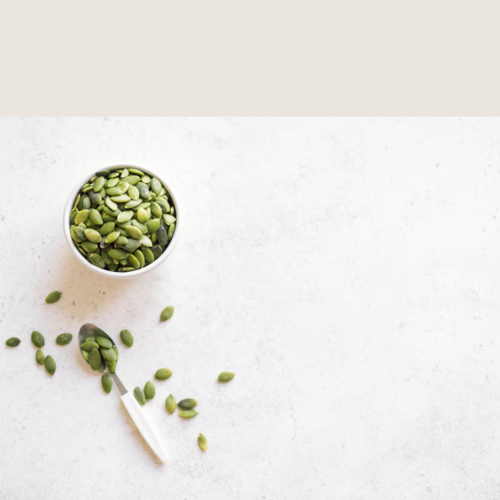
Bottom Line
As mentioned earlier, seed cycling isn’t a cure-all. You can’t expect seed cycling to give you the support you need without prioritizing other hormone-balancing factors like good sleep, stress management, eating well staying hydrated and limiting your exposure to hormone-disrupting toxins.
In conclusion, seed cycling can be an effective and natural way to alleviate symptoms of PMS. By incorporating specific seeds into one’s diet during different phases of the menstrual cycle, hormone levels may be balanced, inflammation may be reduced, and digestion may be improved.
NEED MORE GUIDANCE?
Hormone balance is complex since there are so many factors that play into this delicate balance. It’s important to get your hormone levels tested by a doctor to properly diagnose your condition. Once you have this information a Radically Rooted dietitian can help you make diet and lifestyle changes to balance and maintain optimal hormone levels.


